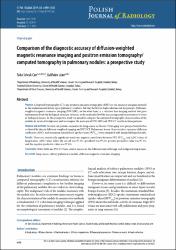Comparison of the diagnostic accuracy of diffusion-weighted magnetic resonance imaging and positron emission tomography/computed tomography in pulmonary nodules: a prospective study
Özet
Purpose: Computed tomography (CT) and positron emission tomography (PET) are the mainstay imaging methods in the evaluation and follow-up of pulmonary nodules. But they both have high radiation risk for patients. Diffusion-weighted magnetic resonance imaging (DW-MRI), on the other hand, is a radiation free imaging method that gives information about the biological structure of tissues at the molecular level by measuring random movement of water in biological tissues. In this prospective study we aimed to compare the computed tomography characteristics of the nodules in terms of malignancy and to compare the accuracy of DW-MRI and PET/CT results in those patients.
Material and methods: Seventy six patients suspicious for lung cancer on thorax CT imaging were prospectively further evaluated by thorax diffusion-weighted imaging and PET/CT. Pulmonary lesion characteristics, apparent diffusion coefficient (ADC), and maximum standardised uptake values (SUVmax) were compared with histopathological results.
Results: There was statistically significant moderate negative correlation between PET-SUVmax and ADC values of lung lesions. ADC values below the cut-off was 97.1%, specificity was 97.6%, positive predictive value was 97.1%, and the negative predictive value was 97.6%.
Conclusions: DAG-MRI and PET/CT have similar success in the differentiation of benign and malignant lung lesions
Cilt
84Bağlantı
https://hdl.handle.net/11363/2008Koleksiyonlar
Aşağıdaki lisans dosyası bu öğe ile ilişkilidir:


















